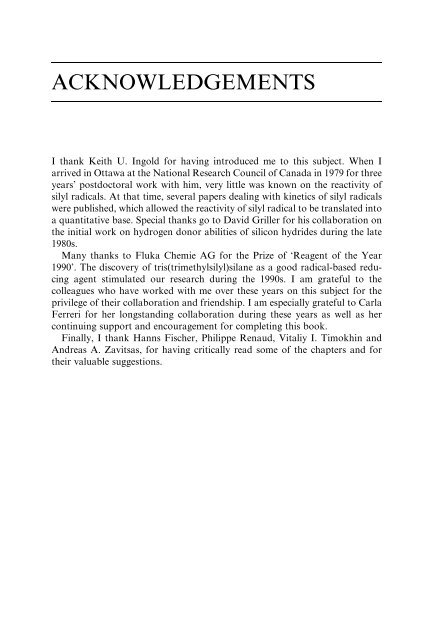"Front Matter". In: Organosilanes in Radical Chemistry - Index of
"Front Matter". In: Organosilanes in Radical Chemistry - Index of "Front Matter". In: Organosilanes in Radical Chemistry - Index of
Preface xi but I have not entered into the field of silicon-containing ceramics obtained by chemical vapour deposition techniques, although gaseous silyl radicals are thought to be essential. Since this book mainly deals with the literature on silyl radicals after the 1980s, the references quoted for the early work are not always the seminal ones but the available reviews. I hope that early experts in the field will forgive me if they find their pet paper uncited. I have tried to maintain an essential simplicity and readability of the text, and hope that I have succeeded so that the book is easily consulted also by nonexperts. I also hope that this book serves as an important link between the various areas of chemistry. Chryssostomos Chatgilialoglu Bologna, July 2003
ACKNOWLEDGEMENTS I thank Keith U. Ingold for having introduced me to this subject. When I arrived in Ottawa at the National Research Council of Canada in 1979 for three years’ postdoctoral work with him, very little was known on the reactivity of silyl radicals. At that time, several papers dealing with kinetics of silyl radicals were published, which allowed the reactivity of silyl radical to be translated into a quantitative base. Special thanks go to David Griller for his collaboration on the initial work on hydrogen donor abilities of silicon hydrides during the late 1980s. Many thanks to Fluka Chemie AG for the Prize of ‘Reagent of the Year 1990’. The discovery of tris(trimethylsilyl)silane as a good radical-based reducing agent stimulated our research during the 1990s. I am grateful to the colleagues who have worked with me over these years on this subject for the privilege of their collaboration and friendship. I am especially grateful to Carla Ferreri for her longstanding collaboration during these years as well as her continuing support and encouragement for completing this book. Finally, I thank Hanns Fischer, Philippe Renaud, Vitaliy I. Timokhin and Andreas A. Zavitsas, for having critically read some of the chapters and for their valuable suggestions.
- Page 1 and 2: Organosilanes in Radical Chemistry
- Page 3 and 4: DEDICATION To my parents XrZstoB an
- Page 5 and 6: viii Contents 3.6 Hydrogen Atom: An
- Page 7: PREFACE A large number of papers de
- Page 11 and 12: 2 Formation and Structures of Silyl
- Page 13 and 14: 4 Formation and Structures of Silyl
- Page 15 and 16: 6 Formation and Structures of Silyl
- Page 17 and 18: 8 Formation and Structures of Silyl
- Page 19 and 20: 10 Formation and Structures of Sily
- Page 21 and 22: 12 Formation and Structures of Sily
- Page 23 and 24: 14 Formation and Structures of Sily
- Page 25 and 26: 16 Formation and Structures of Sily
- Page 27 and 28: 2 Thermochemistry 2.1 GENERAL CONSI
- Page 29 and 30: Bond Dissociation Enthalpies 21 Tab
- Page 31 and 32: Bond Dissociation Enthalpies 23 2.2
- Page 33 and 34: Ion Thermochemistry 25 Table 2.4 Re
- Page 35 and 36: Ion Thermochemistry 27 Table 2.5 El
- Page 37 and 38: References 29 3. Goumri, A., Yuan,
- Page 39 and 40: 32 Hydrogen Donor Abilities of Sili
- Page 41 and 42: 34 Hydrogen Donor Abilities of Sili
- Page 43 and 44: 36 Hydrogen Donor Abilities of Sili
- Page 45 and 46: 38 Hydrogen Donor Abilities of Sili
- Page 47 and 48: 40 Hydrogen Donor Abilities of Sili
- Page 49 and 50: 42 Hydrogen Donor Abilities of Sili
- Page 51 and 52: 44 Hydrogen Donor Abilities of Sili
- Page 53 and 54: 46 Hydrogen Donor Abilities of Sili
- Page 55 and 56: 4 Reducing Agents 4.1 GENERAL ASPEC
- Page 57 and 58: General Aspects of Radical Chain Re
ACKNOWLEDGEMENTS<br />
I thank Keith U. <strong>In</strong>gold for hav<strong>in</strong>g <strong>in</strong>troduced me to this subject. When I<br />
arrived <strong>in</strong> Ottawa at the National Research Council <strong>of</strong> Canada <strong>in</strong> 1979 for three<br />
years’ postdoctoral work with him, very little was known on the reactivity <strong>of</strong><br />
silyl radicals. At that time, several papers deal<strong>in</strong>g with k<strong>in</strong>etics <strong>of</strong> silyl radicals<br />
were published, which allowed the reactivity <strong>of</strong> silyl radical to be translated <strong>in</strong>to<br />
a quantitative base. Special thanks go to David Griller for his collaboration on<br />
the <strong>in</strong>itial work on hydrogen donor abilities <strong>of</strong> silicon hydrides dur<strong>in</strong>g the late<br />
1980s.<br />
Many thanks to Fluka Chemie AG for the Prize <strong>of</strong> ‘Reagent <strong>of</strong> the Year<br />
1990’. The discovery <strong>of</strong> tris(trimethylsilyl)silane as a good radical-based reduc<strong>in</strong>g<br />
agent stimulated our research dur<strong>in</strong>g the 1990s. I am grateful to the<br />
colleagues who have worked with me over these years on this subject for the<br />
privilege <strong>of</strong> their collaboration and friendship. I am especially grateful to Carla<br />
Ferreri for her longstand<strong>in</strong>g collaboration dur<strong>in</strong>g these years as well as her<br />
cont<strong>in</strong>u<strong>in</strong>g support and encouragement for complet<strong>in</strong>g this book.<br />
F<strong>in</strong>ally, I thank Hanns Fischer, Philippe Renaud, Vitaliy I. Timokh<strong>in</strong> and<br />
Andreas A. Zavitsas, for hav<strong>in</strong>g critically read some <strong>of</strong> the chapters and for<br />
their valuable suggestions.



